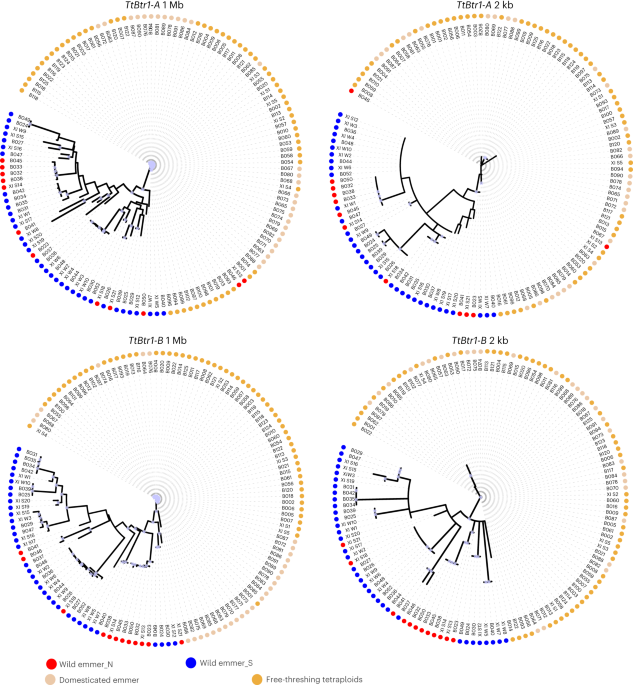Play all audios:
Access through your institution Buy or subscribe replying to Y. Lev-Mirom and A. Distelfeld _Nature Plants_ https://doi.org/10.1038/s41477-023-01468-z (2023) Wheat domestication shifted
human subsistence from foraging to farming, which was a turning point that allowed the rise of civilization1,2. There is immense interest among diverse audiences in better understanding the
process of wheat domestication. For decades, the geographic origin of wheat domestication has been controversial, with hypotheses of the origin from either the northern Levant alone3,4,5,6
or the region spanning both the northern and southern Levant7,8,9,10. Using local sequence analysis of key domestication genes _TtBtr1-A_ and _TtBtr1-B_, our recent study showed evidence for
the former scenario11. In contrast, the earlier work by Nave et al. supported the latter one9. We appreciated the feedback from Lev-Mirom and Distelfeld12 and would like to address the
authors’ critiques. This is a preview of subscription content, access via your institution ACCESS OPTIONS Access through your institution Access Nature and 54 other Nature Portfolio journals
Get Nature+, our best-value online-access subscription $29.99 / 30 days cancel any time Learn more Subscribe to this journal Receive 12 digital issues and online access to articles $119.00
per year only $9.92 per issue Learn more Buy this article * Purchase on SpringerLink * Instant access to full article PDF Buy now Prices may be subject to local taxes which are calculated
during checkout ADDITIONAL ACCESS OPTIONS: * Log in * Learn about institutional subscriptions * Read our FAQs * Contact customer support REFERENCES * Salamini, F., Özkan, H., Brandolini, A.,
Schäfer-Pregl, R. & Martin, W. Genetics and geography of wild cereal domestication in the Near East. _Nat. Rev. Genet._ 3, 429–441 (2002). Article CAS PubMed Google Scholar *
Diamond, J. M. _Guns, germs, and steel: the fates of human societies_ (Norton, 2005). * Zohary, D. Monophyletic vs. polyphyletic origin of the crops on which agriculture was founded in the
Near East. _Genet. Resour. Crop Evol._ 46, 133–142 (1999). Article Google Scholar * Ozkan, H. et al. A reconsideration of the domestication geography of tetraploid wheats. _Theor. Appl.
Genet._ 110, 1052–1060 (2005). Article CAS PubMed Google Scholar * Luo, M.-C. et al. The structure of wild and domesticated emmer wheat populations, gene flow between them, and the site
of emmer domestication. _Theor. Appl. Genet._ 114, 947–959 (2007). Article PubMed Google Scholar * Avni, R. et al. Wild emmer genome architecture and diversity elucidate wheat evolution
and domestication. _Science_ 357, 93–97 (2017). Article CAS PubMed Google Scholar * Willcox, G. The distribution, natural habitats and availability of wild cereals in relation to their
domestication in the Near East: multiple events, multiple centres. _Veg. Hist. Archaeobot._ 14, 534–541 (2005). Article Google Scholar * Fuller, D. Q., Willcox, G. & Allaby, R. G.
Early agricultural pathways: moving outside the ‘core area’ hypothesis in Southwest Asia. _J. Exp. Bot._ 63, 617–633 (2012). Article CAS PubMed Google Scholar * Nave, M. et al. Wheat
domestication in light of haplotype analyses of the Brittle rachis 1 genes (_BTR1-A_ and _BTR1-B_). _Plant Sci._ 285, 193–199 (2019). Article CAS PubMed Google Scholar * Oliveira, H. R.,
Jacocks, L., Czajkowska, B. I., Kennedy, S. L. & Brown, T. A. Multiregional origins of the domesticated tetraploid wheats. _PLoS ONE_ 15, e0227148 (2020). Article CAS PubMed PubMed
Central Google Scholar * Zhao, X. et al. Population genomics unravels the Holocene history of bread wheat and its relatives. _Nat. Plants_ 9, 403–419 (2023). Article PubMed Google
Scholar * Lev-Mirom, Y. & Distelfeld, A. Where was wheat domesticated? _Nat. Plants_ https://doi.org/10.1038/s41477-023-01468-z (2023). Download references AUTHOR INFORMATION Author
notes * These authors contributed equally: Xuebo Zhao, Yafei Guo. AUTHORS AND AFFILIATIONS * State Key Laboratory of Plant Cell and Chromosome Engineering, Institute of Genetics and
Developmental Biology, Innovative Academy of Seed Design, Chinese Academy of Sciences, Beijing, China Xuebo Zhao, Yafei Guo & Fei Lu * University of Chinese Academy of Sciences, Beijing,
China Xuebo Zhao, Yafei Guo & Fei Lu * CAS-JIC Centre of Excellence for Plant and Microbial Science, Institute of Genetics and Developmental Biology, Chinese Academy of Sciences,
Beijing, China Fei Lu Authors * Xuebo Zhao View author publications You can also search for this author inPubMed Google Scholar * Yafei Guo View author publications You can also search for
this author inPubMed Google Scholar * Fei Lu View author publications You can also search for this author inPubMed Google Scholar CONTRIBUTIONS X.Z. and Y.G. performed the data analysis,
plotted the paper figures and drafted the paper. F.L. coordinated the project and finalized the paper. All authors discussed the results and commented on the paper. CORRESPONDING AUTHOR
Correspondence to Fei Lu. ETHICS DECLARATIONS COMPETING INTERESTS The authors declare no competing interests. PEER REVIEW PEER REVIEW INFORMATION _Nature Plants_ thanks Alexandra
Przewieslik-Allen and the other, anonymous, reviewer(s) for their contribution to the peer review of this work. ADDITIONAL INFORMATION PUBLISHER’S NOTE Springer Nature remains neutral with
regard to jurisdictional claims in published maps and institutional affiliations. SUPPLEMENTARY INFORMATION REPORTING SUMMARY RIGHTS AND PERMISSIONS Reprints and permissions ABOUT THIS
ARTICLE CITE THIS ARTICLE Zhao, X., Guo, Y. & Lu, F. Reply to: Where was wheat domesticated?. _Nat. Plants_ 9, 1203–1206 (2023). https://doi.org/10.1038/s41477-023-01468-z Download
citation * Received: 05 June 2023 * Accepted: 25 June 2023 * Published: 24 July 2023 * Issue Date: August 2023 * DOI: https://doi.org/10.1038/s41477-023-01468-z SHARE THIS ARTICLE Anyone you
share the following link with will be able to read this content: Get shareable link Sorry, a shareable link is not currently available for this article. Copy to clipboard Provided by the
Springer Nature SharedIt content-sharing initiative

